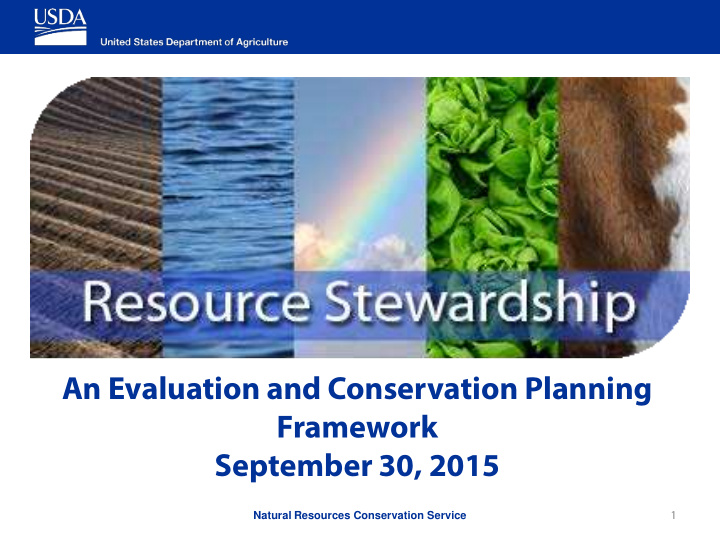



An Evaluation and Conservation Planning Framework September 30, 2015 Natural Resources Conservation Service 1
Driving Forces Demand on food and fiber – and natural resources – is increasing. By 2050, the world will have to Extreme weather events, like the feed 2 billion more people , a California drought and Hurricane total population of 9 billion. Sandy are expected to become commonplace. Natural Resources Conservation Service
Agribusiness Requirements Natural Resources Conservation Service
Marketplace Drivers The European Union and other countries, as well as corporations such as Wal-Mart, are addressing these issues by: Requiring sustainability goals Conducting lifecycle analyses Building a reliable supply chain Requiring Transparent Metrics Natural Resources Conservation Service
NRCS Objectives • To better align and use our technical tools to enhance our conservation planning capabilities • To utilize transparent and uniform stewardship metrics for farmers and ranchers • To better estimate and communicate the benefits of conservation stewardship • Framework to provide recognition and benefits both internal to USDA and external for good stewardship. Natural Resources Conservation Service
Resource Stewardship Framework • Includes a Resource Stewardship Evaluation (RSE) and the development of Conservation Plan which meets or exceeds the Resource Thresholds. The Framework assists producers in achieving a stewardship level of conservation and better communicate the stewardship benefits of conservation. • Leads to a Precision Conservation Plan with a quantitative Quality Level and Conservation Effects Natural Resources Conservation Service 6
Resource Stewardship Framework The Resource Stewardship Evaluation (RSE) is a process where we use our best analytical tools to measure four categories of resource concerns on a farm or ranch against stewardship threshold levels. • Soil and resource health • Water quality and quantity • Air quality • Habitat health Natural Resources Conservation Service 7
Key Concepts • Stewardship not sustainability • Science-based evaluation • Resource management systems (RMS) • Management on the land • Planning thresholds Natural Resources Conservation Service 8
What’s Excluded Not traditional NRCS Resource Concerns – Animal welfare – Genetically modified organisms (GMOs) – Labor, worker safety and protection – Food safety NRCS Resource Concerns – Energy (Threshold not ready) Natural Resources Conservation Service 9
Evaluation Tools Tool Notes Revised Universal Soil Loss Equation RUSLE2 Wind Erosion Prediction System WEPS Stewardship Tool for Environmental Performance STEP Windows Pesticide Screening Tool WINPST Farm Irrigation Rating Index FIRI Whole Farm and Ranch Carbon and Greenhouse Gas Accounting System COMET Wildlife Habitat Evaluation Guides for Wildlife and Stream Evaluation WHEG Rangeland Health Assessment RHA Pasture Condition Score PCS Natural Resources Conservation Service
Stewardship Objectives Soil Health Water Quality Water Quantity Air Quality Habitat Health Combined Benchmark Combined Planned Natural Resources Conservation Service
Key Indicators Cropland Stewardship Key Indicators Erosion Management (Water) Erosion Management (Wind) Soil Organic Matter Management NM: Phosphorus to Surface Water NM: Nitrogen to Surface Water NM: Nitrogen to Groundwater Sediment Management Pesticide Management Irrigation Management Greenhouse Gas Management Terrestrial Habitats Aquatic Habitats Benchmark Planned Natural Resources Conservation Service
Communicating with Clients Cropland Stewardship Objectives Soil Health Water Quality Water Quantity Air Quality Habitat Health Combined Benchmark Combined Planned Conservation Practices and Mitigation Techniques Planned Benchmark • Residue and Tillage Management, No-Till (329) • Residue and Tillage Management, No-Till (329) • Conservation Crop Rotation (328) • Conservation Crop Rotation (328) • Filter Strip (393) • Filter Strip (393) • Irrigation Water Management (449) • Irrigation Water Management (449) • Cover Crop (340) • Riparian Forest Buffer (391) Natural Resources Conservation Service 13
Resource Stewardship provides Value Added Conservation Planning • All activity occurs within the Conservation Planning Process • Built on Conservation Planning Resource Concerns, Planning Criteria, and Assessment Tools and Methods • Encourages more Holistic Planning Leads to a Conservation Plan with discernable Quality Level and Conservation Effects Natural Resources Conservation Service
Water Quality Effects of Resource Stewardship 10,000,000,000 9,000,000,000 8,000,000,000 7,000,000,000 6,000,000,000 5,000,000,000 4,000,000,000 3,000,000,000 2,000,000,000 1,000,000,000 0 Total P Loss (lbs) Surface N Loss (lbs) Subsurface N Loss (lbs) No Practices Current Total at Stewardship Natural Resources Conservation Service 15
2015 Pilot States Small geographic area in each state Natural Resources Conservation Service 16
Results • Over 100 diverse tracts evaluated thus far • Significantly improving conservation – precision conservation • Major improvements foreseeable in water quality, especially related to nutrient leaching – some farmers made immediate changes to meet threshold level • Increased leverage through immediate access to EQIP to achieve stewardship level • Currently preparing report Natural Resources Conservation Service 17
Maryland Pilot Natural Resources Conservation Service
Louisiana Pilot Natural Resources Conservation Service 19
Feedback “This helps farmers to see long term goals instead of short term production and where the strengths and weakness of their farm are. This will help them to conserve their farm for future generations.” - Jack Bensink, Bensink Farms Ltd. I have used the STEP-Nutrients to show incorporating cover crops into a current system brings Water Quality Issues from not meeting the threshold to meeting the threshold. – District Conservationist, Iowa One producer who showed some resource concerns that need to be addressed said “I am going to definitely go back to no-till on those steep hillsides and take the wear and tear on my bean planter.” - District Conservationist, Iowa This tool has the potential to help us rank applications so we are funding where we can achieve the greatest benefit in improvements from the existing system. - District Conservationist, Iowa Natural Resources Conservation Service 20
Delaware Farm Natural Resources Conservation Service 21
Delaware Farm Natural Resources Conservation Service 22
Delaware Farm Natural Resources Conservation Service 23
Delaware Farm Natural Resources Conservation Service 24
Expanded Scope for FY 2016 • Coordinate with the National Water Quality Initiative (NWQI) to promote utilization of the RSE for conservation planning and communicating benefits of Resource Stewardship • Continue existing State Pilots • Support new State/Partner RS Pilots and Projects • Harmonizing metrics with partners Natural Resources Conservation Service 25
Ideas? Comments? Questions? Natural Resources Conservation Service
Recommend
More recommend